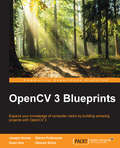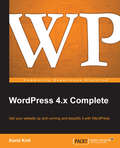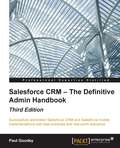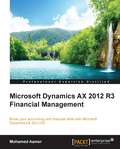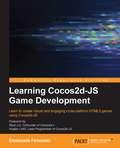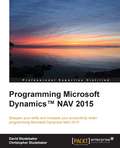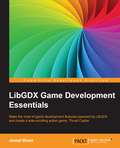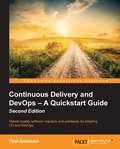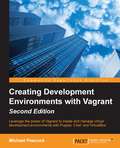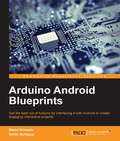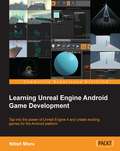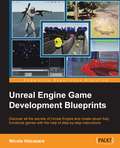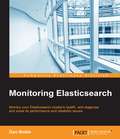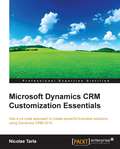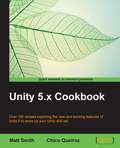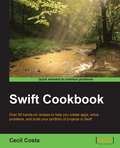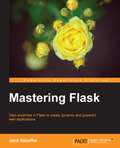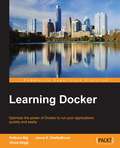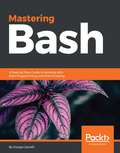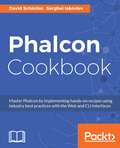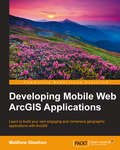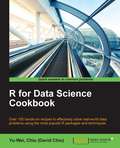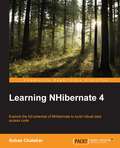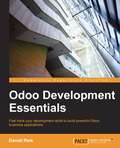- Table View
- List View
OpenCV 3 Blueprints
by Joseph Howse Steven Puttemans Quan Hua Utkarsh SinhaExpand your knowledge of computer vision by building amazing projects with OpenCV 3About This BookBuild computer vision projects to capture high-quality image data, detect and track objects, process the actions of humans or animals, and much moreDiscover practical and interesting innovations in computer vision while building atop a mature open-source library, OpenCV 3Familiarize yourself with multiple approaches and theories wherever critical decisions need to be madeWho This Book Is ForThis book is ideal for you if you aspire to build computer vision systems that are smarter, faster, more complex, and more practical than the competition. This is an advanced book intended for those who already have some experience in setting up an OpenCV development environment and building applications with OpenCV. You should be comfortable with computer vision concepts, object-oriented programming, graphics programming, IDEs, and the command line.What You Will LearnSelect and configure camera systems to see invisible light, fast motion, and distant objectsBuild a "camera trap", as used by nature photographers, and process photos to create beautiful effectsDevelop a facial expression recognition system with various feature extraction techniques and machine learning methodsBuild a panorama Android application using the OpenCV stitching module in C++ with NDK supportOptimize your object detection model, make it rotation invariant, and apply scene-specific constraints to make it faster and more robustCreate a person identification and registration system based on biometric properties of that person, such as their fingerprint, iris, and faceFuse data from videos and gyroscopes to stabilize videos shot from your mobile phone and create hyperlapse style videosIn DetailComputer vision is becoming accessible to a large audience of software developers who can leverage mature libraries such as OpenCV. However, as they move beyond their first experiments in computer vision, developers may struggle to ensure that their solutions are sufficiently well optimized, well trained, robust, and adaptive in real-world conditions. With sufficient knowledge of OpenCV, these developers will have enough confidence to go about creating projects in the field of computer vision.This book will help you tackle increasingly challenging computer vision problems that you may face in your careers. It makes use of OpenCV 3 to work around some interesting projects. Inside these pages, you will find practical and innovative approaches that are battle-tested in the authors' industry experience and research. Each chapter covers the theory and practice of multiple complementary approaches so that you will be able to choose wisely in your future projects. You will also gain insights into the architecture and algorithms that underpin OpenCV's functionality.We begin by taking a critical look at inputs in order to decide which kinds of light, cameras, lenses, and image formats are best suited to a given purpose. We proceed to consider the finer aspects of computational photography as we build an automated camera to assist nature photographers. You will gain a deep understanding of some of the most widely applicable and reliable techniques in object detection, feature selection, tracking, and even biometric recognition. We will also build Android projects in which we explore the complexities of camera motion: first in panoramic image stitching and then in video stabilization.By the end of the book, you will have a much richer understanding of imaging, motion, machine learning, and the architecture of computer vision libraries and applications!Style and approachThis book covers a combination of theory and practice. We examine blueprints for specific projects and discuss the principles behind these blueprints, in detail.
WordPress 4.x Complete
by Karol KrolIf you want a website at low cost, without the need to hire a team of developers and designers, then this book is for you. It will help you take your first steps into the world of website creation.
Salesforce CRM – The Definitive Admin Handbook - Third Edition
by Paul GoodeyThis book is for administrators who want to develop and strengthen their Salesforce CRM skills in the areas of configuration and system management. Whether you are a novice or a more experienced administrator, this book aims to enhance your knowledge and understanding of the Salesforce CRM platform and features.
Microsoft Dynamics AX 2012 R3 Financial Management
by Mohamed AamerThis book is intended for application consultants, controllers, CFOs, and other professionals who are engaged in a Microsoft Dynamics AX implementation project. Basic knowledge of financial terms, concepts, and Microsoft Dynamics AX terminologies is required.
Learning Cocos2d-JS Game Development
by Emanuele FeronatoIf you are new to game development or have just gotten your teeth into developing games but desire to learn more, then this book is for you. An understanding of the essentials of JavaScript is required.
Programming Microsoft Dynamics™ NAV 2015
by David Studebaker Christopher StudebakerThis book is targeted at those who want to learn NAV's powerful and extensive built-in development capabilities. It assumes that you understand programming and are familiar with business application software.
LibGDX Game Development Essentials
by Juwal BoseIf you are a Java developer who wants to learn LibGDX and create great games, then this book is for you. To take full advantage of this book, you are expected to be familiar with Java or any other object-oriented language. Experience of using Eclipse will be very useful.
Continuous Delivery and DevOps – A Quickstart Guide - Second Edition
by Paul SwartoutIf you are an IT professional, software developer, or system administrator who wants to understand how to ship quality software regularly, effectively and efficiently, this book is for you. Previous knowledge of DevOps practices, Continuous Delivery, or using DevOps tools is not necessary.
Creating Development Environments with Vagrant - Second Edition
by Michael PeacockIf you are a developer who wants to have your development environment accurately reflect your live servers to tackle the ever-increasing complexity of web and software projects, this book is most certainly intended for you! It's assumed that you know the basics of Linux systems in the context of web-based projects.
Arduino Android Blueprints
by Marco Schwartz Stefan ButtigiegThis book is for those who want to learn how to build exciting Arduino projects by interfacing it with Android. You will need to have some basic experience in electronics and programming. However, you don't need to have any previous experience with the Arduino or Android platforms.
Learning Unreal Engine Android Game Development
by Nitish MisraIf you are a game developer, designer, artist, or a beginner in the gaming industry and want to make Android games with Unreal Engine 4 efficiently, this book is ideal for you.
Unreal Engine Game Development Blueprints
by Nicola ValcasaraDiscover all the secrets of Unreal Engine and create seven fully functional games with the help of step-by-step instructions About This Book * Understand what a Blueprint is and how to create a complex visual scripting code * Discover the infinite possibilities that Unreal Engine offers, and understand which tool to use, where and when * Learn to think like a real game developer in order to create enjoyable and bug-free games using this comprehensive and practical handbook Who This Book Is For This book is ideal for intermediate level developers who know how to use Unreal Engine and want to go through a series of projects that will further their expertise. Working knowledge of C++ is a must. What You Will Learn * Write clean and reusable Blueprint scripts * Develop any kind of game you have in mind, following the rules used by experts * Move through Unreal Engine 4, always knowing what you are doing and where to find the right tool for your needs * Integrate C++ code into your projects using Visual Studio and the tools that Unreal provides * Extricate between classes, nodes, interfaces, macros, and functions * Work with different types of assets, from 3D objects to audio sources, from UI buttons to animations * Explore all the aspects of the game logic--collisions, navigation meshes, matinees, volumes, events, and states In Detail With the arrival of Unreal Engine 4, a new wonderful tool was born: Blueprint. This visual scripting tool allows even non-programmers to develop the logic for their games, allowing almost anyone to create entire games without the need to write a single line of code. The range of features you can access with Blueprint script is pretty extensive, making it one of the foremost choices for many game developers. Unreal Engine Game Development Blueprints helps you unleash the real power of Unreal by helping you to create engaging and spectacular games. It will explain all the aspects of developing a game, focusing on visual scripting, and giving you all the information you need to create your own games. We start with an introductory chapter to help you move fluidly inside the Blueprint user interface, recognize its different components, and understand any already written Blueprint script. Following this, you will learn how to modify generated Blueprint classes to produce a single player tic-tac-toe game and personalize it. Next, you will learn how to create simple user interfaces, and how to extend Blueprints through code. This will help you make an informed decision between choosing Blueprint or code. You will then see the real power of Unreal unleashed as you create a beautiful scene with moving, AI controlled objects, particles, and lights. Then, you will learn how to create AI using a behavior tree and a global level Blueprint, how to modify the camera, and how to shoot custom bullets. Finally, you will create a complex game using Blueprintable components complete with a menu, power-up, dangerous objects, and different weapons. Style and approach This is an easy-to-follow guide full of practical game examples. Each chapter contains step-by-step instructions to build a complete game and each game uses a different tool in order to cover all the topics in a detailed and progressive manner.
Monitoring Elasticsearch
by Dan NobleMonitor your Elasticsearch cluster's health, and diagnose and solve its performance and reliability issues About This Book * Understand common performance and reliability pitfalls in ElasticSearch * Use popular monitoring tools such as ElasticSearch-head, BigDesk, Marvel, Kibana, and more * This is a step-by-step guide with lots of case studies on solving real-world ElasticSearch cluster issues Who This Book Is For This book is for developers and system administrators who use ElasticSearch in a wide range of capacities. Prior knowledge of ElasticSearch and related technologies would be helpful, but is not necessary. What You Will Learn * Explore your cluster with ElasticSearch-head and BigDesk * Access the underlying data of the ElasticSearch monitoring plugins using the ElasticSearch API * Analyze your cluster's performance with Marvel * Troubleshoot some of the common performance and reliability issues that come up when using ElasticSearch * Analyze a cluster's historical performance, and get to the bottom of and recover from system failures * Use and install various other tools and plugins such as Kibana and Kopf, which is helpful to monitor ElasticSearch In Detail ElasticSearch is a distributed search server similar to Apache Solr with a focus on large datasets, a schema-less setup, and high availability. This schema-free architecture allows ElasticSearch to index and search unstructured content, making it perfectly suited for both small projects and large big data warehouses with petabytes of unstructured data. This book is your toolkit to teach you how to keep your cluster in good health, and show you how to diagnose and treat unexpected issues along the way. You will start by getting introduced to ElasticSearch, and look at some common performance issues that pop up when using the system. You will then see how to install and configure ElasticSearch and the ElasticSearch monitoring plugins. Then, you will proceed to install and use the Marvel dashboard to monitor ElasticSearch. You will find out how to troubleshoot some of the common performance and reliability issues that come up when using ElasticSearch. Finally, you will analyze your cluster's historical performance, and get to know how to get to the bottom of and recover from system failures. This book will guide you through several monitoring tools, and utilizes real-world cases and dilemmas faced when using ElasticSearch, showing you how to solve them simply, quickly, and cleanly. Style and approach This is a step-by-step guide to monitoring your ElasticSearch cluster and correcting performance issues. It is filled with lots of in-depth, real-world use-cases on solving different ElasticSearch cluster issues.
Microsoft Dynamics CRM Customization Essentials
by Nicolae TarlaIf you are new to Dynamics CRM or a seasoned user looking to enhance your knowledge of the platform, then this book is for you. It is also for skilled developers who are looking to move to the Microsoft stack to build business solution software.
Unity 4.x Cookbook
by Chico Queiroz Matt SmithCookbook. From beginners to advanced users, from artists to coders, this book is for you and everyone in your team! This book is for anyone who wants to explore a wide range of Unity scripting and multimedia features and to find ready to use solutions to many game features. Programmers can explore multimedia features, and multimedia developers can try their hand at scripting.
Swift Cookbook
by Cecil CostaIf you are an experienced Objective-C programmer and are looking for quick solutions to many different coding tasks in Swift, then this book is for you. You are expected to have development experience, though not necessarily with Swift.
Mastering Flask
by Jack StoufferGain expertise in Flask to create dynamic and powerful web applications About This Book * Work with scalable Flask application structures to create complex web apps * Discover the most powerful Flask extensions and learn how to create one * Deploy your application to real-world platforms using this step-by-step guide Who This Book Is For If you are a Flask user who knows the basics of the library and how to create basic web pages with HTML and CSS, and you want to take your applications to the next level, this is the book for you. Harnessing the full power of Flask will allow you to create complex web applications with ease. What You Will Learn * Set up a best practices Python environment * Use SQLAlchemy to programmatically query a database * Develop templates in Jinja * Set up an MVC environment for Flask * Discover NoSQL, when to use it, when not to, and how to use it * Develop a custom Flask extension * Use Celery to create asynchronous tasks * Use py.test to create unit tests In Detail Flask is a library that allows programmers to create web applications in Python. Flask is a micro-framework that boasts a low learning curve, a large community, and the power to create complex web apps. However, Flask is easy to learn but difficult to master. Starting from a simple Flask app, this book will walk through advanced topics while providing practical examples of the lessons learned. After building a simple Flask app, a proper app structure is demonstrated by transforming the app to use a Model-View-Controller (MVC) architecture. With a scalable structure in hand, the next chapters use Flask extensions to provide extra functionality to the app, including user login and registration, NoSQL querying, a REST API, an admin interface, and more. Next, you'll discover how to use unit testing to take the guesswork away from making sure the code is performing as it should. The book closes with a discussion of the different platforms that are available to deploy a Flask app on, the pros and cons of each one, and how to deploy on each one. Style and approach With plenty of useful examples, this guide introduces new concepts and then shows you how those concepts can be used in a real-world environment. Most sections are based around a single example app that is developed throughout the book.
Learning Docker
by Pethuru Raj Jeeva S. ChelladhuraiIf you are an application developer who wants to learn Docker in order to utilize its features for application deployment, then this book is for you. No prior knowledge of Docker is required.
Mastering Bash
by Giorgio ZarrelliYour one stop guide to making the most out of Bash programming About This Book • From roots to leaves, learn how to program in Bash and automate daily tasks, pouring some spice in your scripts • Daemonize a script and make a real service of it, ensuring it's available at any time to process user-fed data or commands • This book provides functional examples that show you practical applications of commands Who This Book Is For If you're a power user or system administrator involved in writing Bash scripts to automate tasks, then this book is for you. This book is also ideal for advanced users who are engaged in complex daily tasks. What You Will Learn • Understand Bash right from the basics and progress to an advanced level • Customise your environment and automate system routine tasks • Write structured scripts and create a command-line interface for your scripts • Understand arrays, menus, and functions • Securely execute remote commands using ssh • Write Nagios plugins to automate your infrastructure checks • Interact with web services, and a Slack notification script • Find out how to execute subshells and take advantage of parallelism • Explore inter-process communication and write your own daemon In Detail System administration is an everyday effort that involves a lot of tedious tasks, and devious pits. Knowing your environment is the key to unleashing the most powerful solution that will make your life easy as an administrator, and show you the path to new heights. Bash is your Swiss army knife to set up your working or home environment as you want, when you want. This book will enable you to customize your system step by step, making your own real, virtual, home out of it. The journey will take you swiftly through the basis of the shell programming in Bash to more interesting and challenging tasks. You will be introduced to one of the most famous open source monitoring systems—Nagios, and write complex programs with it in any languages. You'll see how to perform checks on your sites and applications. Moving on, you'll discover how to write your own daemons so you can create your services and take advantage of inter-process communication to let your scripts talk to each other. So, despite these being everyday tasks, you'll have a lot of fun on the way. By the end of the book, you will have gained advanced knowledge of Bash that will help you automate routine tasks and manage your systems. Style and approach This book presents step-by-step instructions and expert advice on working with Bash and writing scripts. Starting from the basics, this book serves as a reference manual where you can find handy solutions and advice to make your scripts flexible and powerful.
Phalcon Cookbook
by David Schissler Serghei IakovlevMaster Phalcon by implementing hands-on recipes using industry best practices with the Web and CLI interfaces About This Book * Create quick prototypes with the Phalcon Developer Tools * Learn to use the powerful and uniquely efficient Phalcon ORM * Reuse codes in real projects Who This Book Is For If you are a beginner-to-intermediate Phalcon developer who wants to level up or an advanced user who is seeking some new techniques and insight, then this book is perfect for you. This book will be relevant to you over a long period of time due to the mixed nature of this book in providing both abstract comprehension as well as specific examples meant to be usable in your projects. You will be able to experiment with each new aspect of integration in prebuilt recipes meant to best illustrate each specific feature. This will save you lots of time getting up to speed before attempting to integrate into a real application. What You Will Learn * Install the Phalcon extension from both premade packages and source code * Create a normal and micro application structure * Understand the dispatcher event cycle and create custom plugins * Get hands-on using the Phalcon Query Language and ORM * Create flexible views with the Volt template system * Leverage Phalcon to prevent common security vulnerabilities * Optimize an application with focused solutions * Profile and debug an application to get increased reliability In Detail Phalcon is a high-performance PHP framework delivered as a PHP extension. This provides new opportunities for speed and application design, which until recently have been unrealized in the PHP ecosystem. Packed with simple learning exercises, technology prototypes, and real-world usable code, this book will guide you from the beginner and setup stage all the way to advanced usage. You will learn how to avoid niche pitfalls, how to use the command-line developer tools, how to integrate with new web standards, as well as how to set up and customize the MVC application structure. You will see how Phalcon can be used to quickly set up a single file web application as well as a complex multi-module application suitable for long-term projects. Some of the recipes focus on abstract concepts that are vital to get a deep comprehension of Phalcon and others are designed as a vehicle to deliver real-world usable classes and code snippets to solve advanced problems. You'll start out with basic setup and application structure and then move onto the Phalcon MVC and routing implementation, the power of the ORM and Phalcon Query Language, and Phalcon's own Volt templating system. Finally, you will move on to caching, security, and optimization. Style and approach An easy-to-start guide that provides
Developing Mobile Web ArcGIS Applications
by Matthew SheehanThis guide is invaluable to those just starting out with GIS development but will also benefit GIS professionals wishing to expand their development skills to include mobile apps.
Advanced Penetration Testing for Highly-Secured Environments - Second Edition
by Kevin Cardwell Lee AllenEmploy the most advanced pentesting techniques and tools to build highly-secured systems and environments About This Book * Learn how to build your own pentesting lab environment to practice advanced techniques * Customize your own scripts, and learn methods to exploit 32-bit and 64-bit programs * Explore a vast variety of stealth techniques to bypass a number of protections when penetration testing Who This Book Is For This book is for anyone who wants to improve their skills in penetration testing. As it follows a step-by-step approach, anyone from a novice to an experienced security tester can learn effective techniques to deal with highly secured environments. Whether you are brand new or a seasoned expert, this book will provide you with the skills you need to successfully create, customize, and plan an advanced penetration test. What You Will Learn * A step-by-step methodology to identify and penetrate secured environments * Get to know the process to test network services across enterprise architecture when defences are in place * Grasp different web application testing methods and how to identify web application protections that are deployed * Understand a variety of concepts to exploit software * Gain proven post-exploitation techniques to exfiltrate data from the target * Get to grips with various stealth techniques to remain undetected and defeat the latest defences * Be the first to find out the latest methods to bypass firewalls * Follow proven approaches to record and save the data from tests for analysis In Detail The defences continue to improve and become more and more common, but this book will provide you with a number or proven techniques to defeat the latest defences on the networks. The methods and techniques contained will provide you with a powerful arsenal of best practices to increase your penetration testing successes. The processes and methodology will provide you techniques that will enable you to be successful, and the step by step instructions of information gathering and intelligence will allow you to gather the required information on the targets you are testing. The exploitation and post-exploitation sections will supply you with the tools you would need to go as far as the scope of work will allow you. The challenges at the end of each chapter are designed to challenge you and provide real-world situations that will hone and perfect your penetration testing skills. You will start with a review of several well respected penetration testing methodologies, and following this you will learn a step-by-step methodology of professional security testing, including stealth, methods of evasion, and obfuscation to perform your tests and not be detected! The final challenge will allow you to create your own complex layered architecture with defences and protections in place, and provide the ultimate testing range for you to practice the methods shown throughout the book. The challenge is as close to an actual penetration test assignment as you can get! Style and approach The book follows the standard penetration testing stages from start to finish with step-by-step examples. The book thoroughly covers penetration test expectations, proper scoping and planning, as well as enumeration and foot printing
R for Data Science Cookbook
by Chiu Yu-WeiOver 100 hands-on recipes to effectively solve real-world data problems using the most popular R packages and techniques About This Book * Gain insight into how data scientists collect, process, analyze, and visualize data using some of the most popular R packages * Understand how to apply useful data analysis techniques in R for real-world applications * An easy-to-follow guide to make the life of data scientist easier with the problems faced while performing data analysis Who This Book Is For This book is for those who are already familiar with the basic operation of R, but want to learn how to efficiently and effectively analyze real-world data problems using practical R packages. What You Will Learn * Get to know the functional characteristics of R language * Extract, transform, and load data from heterogeneous sources * Understand how easily R can confront probability and statistics problems * Get simple R instructions to quickly organize and manipulate large datasets * Create professional data visualizations and interactive reports * Predict user purchase behavior by adopting a classification approach * Implement data mining techniques to discover items that are frequently purchased together * Group similar text documents by using various clustering methods In Detail This cookbook offers a range of data analysis samples in simple and straightforward R code, providing step-by-step resources and time-saving methods to help you solve data problems efficiently. The first section deals with how to create R functions to avoid the unnecessary duplication of code. You will learn how to prepare, process, and perform sophisticated ETL for heterogeneous data sources with R packages. An example of data manipulation is provided, illustrating how to use the "dplyr" and "data.table" packages to efficiently process larger data structures. We also focus on "ggplot2" and show you how to create advanced figures for data exploration. In addition, you will learn how to build an interactive report using the "ggvis" package. Later chapters offer insight into time series analysis on financial data, while there is detailed information on the hot topic of machine learning, including data classification, regression, clustering, association rule mining, and dimension reduction. By the end of this book, you will understand how to resolve issues and will be able to comfortably offer solutions to problems encountered while performing data analysis. Style and approach This easy-to-follow guide is full of hands-on examples of data analysis with R. Each topic is fully explained beginning with the core concept, followed by step-by-step practical examples, and concluding with detailed explanations of each concept used.
Learning NHibernate 4
by Suhas ChatekarThis book targets .NET developers who have never used an ORM before, developers who have used an ORM before but are new to NHibernate, or have used NHibernate sparingly and want to learn more about NHibernate.
Odoo Development Essentials
by Daniel ReisThis book is intended for developers who need to quickly become productive with Odoo. You are expected to have experience developing business applications, as well as an understanding of MVC application design and knowledge of the Python programming language.
